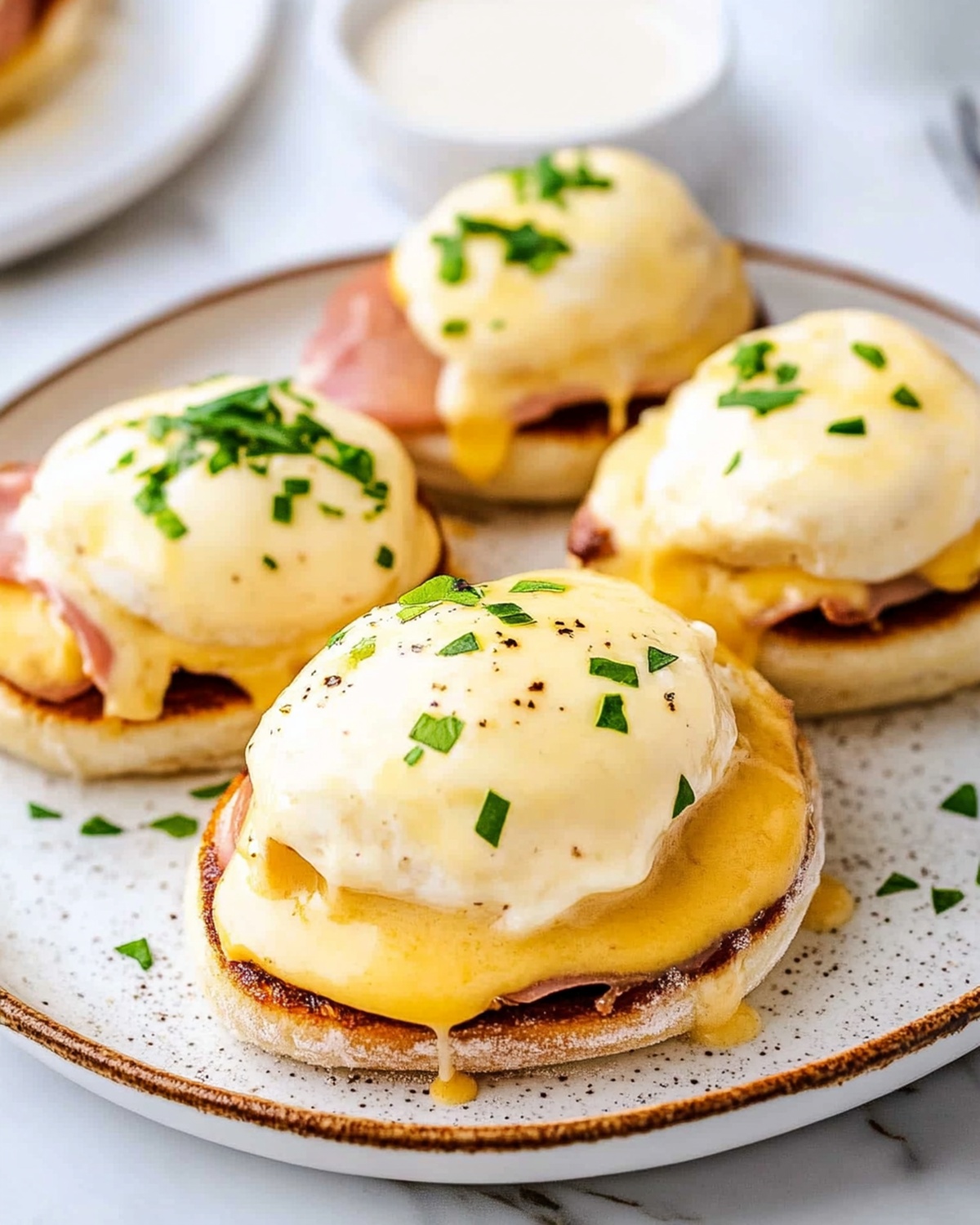The Foolproof Eggs Benedict Recipe: Brunch’s Finest Star
Crafting a delectable eggs benedict requires skill and a touch of culinary magic.
Rich hollandaise sauce and perfectly poached eggs create a breakfast masterpiece that feels luxurious.
Crisp canadian bacon nestles between toasted english muffins, adding layers of savory goodness.
Each bite promises a harmonious blend of creamy, tangy, and salty flavors.
Restaurants might charge premium prices, but you can master this classic dish at home with confidence.
Professionals and home cooks alike appreciate the elegant simplicity of this brunch favorite.
Dive into this recipe and impress everyone at your next weekend gathering.
Why Eggs Benedict Is A Classic Favorite
Ingredients For Making Eggs Benedict
Eggs and Protein:Base and Bread:Sauce and Seasonings:How To Prepare Eggs Benedict At Home
Step 1: Prepare Poaching Water
Fill a large pot with water and bring it to a rolling boil. Add a splash of vinegar and reduce the heat to create a gentle, simmering environment for your eggs.
Step 2: Gently Poach Eggs
Carefully crack each egg into a small ramekin. Slowly slide the eggs into the simmering water, creating a delicate whirlpool to help the egg whites wrap around the yolk. Cook four eggs at a time.
Step 3: Create Perfect Poached Eggs
Remove the pot from heat and cover with a lid. Let the eggs rest in the hot water for approximately 4 minutes. This allows the whites to set while keeping the yolks wonderfully runny and golden.
Step 4: Remove and Drain Eggs
Use a slotted spoon to lift the poached eggs from the water. Gently place them on a paper towel-lined plate to absorb excess moisture. Repeat the poaching process for any remaining eggs.
Step 5: Crisp the Bacon
Heat a skillet over medium-high heat. Lay the back bacon slices in the pan and cook until they develop a beautiful golden-brown color on both sides. The edges should be slightly crisp and deliciously caramelized.
Step 6: Toast English Muffins
Set the oven to broil. Spread a layer of butter on each English muffin half. Arrange the muffins cut-side up on a baking sheet, preparing them for a quick golden toasting.
Step 7: Create Golden Muffin Bases
Slide the baking sheet under the broiler. Watch carefully as the muffins transform into golden, crispy bases that will support your eggs benedict. This should take 1-3 minutes.
Step 8: Assemble the Masterpiece
Arrange the crispy bacon on each toasted muffin half. Delicately place a perfectly poached egg on top of each slice. Generously spoon hollandaise sauce over the eggs. Sprinkle finely chopped chives as a final flourish of flavor and color.
Helpful Tips For Better Eggs Benedict
Ways To Customize Eggs Benedict Your Way
Perfect Sides With Eggs Benedict
How To Store Eggs Benedict The Right Way
Common Questions About Eggs Benedict
A poached egg is an egg cracked into simmering water and cooked gently without its shell, resulting in a soft white and runny yolk.
Vinegar helps the egg whites coagulate faster and stay together, preventing them from spreading out in the water during cooking.
Yes, you can prepare hollandaise sauce ahead of time and gently reheat it over low heat, stirring constantly to prevent separation.
You can use regular bacon, Canadian bacon, ham, or even smoked salmon as alternatives to back bacon in Eggs Benedict.
Print
Eggs Benedict Recipe
- Total Time: 20 minutes
- Yield: 4 1x
Description
Indulgent Eggs Benedict brings classic brunch elegance to your morning table with Canadian bacon, perfectly poached eggs, and rich hollandaise sauce. Creamy, tangy flavors blend seamlessly, inviting you to savor each luxurious bite of this timeless breakfast favorite.
Ingredients
Main Protein:
- 8 large eggs
- 8 slices back bacon (Canadian bacon)
Bread and Base:
- 4 English muffins (halved)
- 1/4 cup butter (softened)
Sauce and Garnish:
- 1 cup hollandaise sauce
- 1 tablespoon white vinegar
- 1 tablespoon chives (finely chopped)
Instructions
- Prepare a simmering water bath by filling a pot with water, adding vinegar, and reducing heat to create gentle bubbles.
- Carefully transfer each egg from its ramekin into the warm water, ensuring a delicate descent to maintain egg integrity.
- Allow eggs to poach for approximately 4 minutes, monitoring the transformation of whites from translucent to opaque while preserving liquid yolk centers.
- Extract poached eggs using a perforated utensil, gently patting dry on absorbent toweling to remove excess moisture.
- Activate a skillet over medium-high temperature, searing back bacon until edges crisp and surface develops rich caramelized tones.
- Position oven rack near broiler element, spreading butter across English muffin surfaces to ensure even golden coloration.
- Slide muffin halves under broiler, watching carefully for 1-2 minutes until edges transform into crisp, amber-hued surfaces.
- Construct each benedict layer strategically: muffin foundation, crisp bacon layer, carefully positioned poached egg, then cascade hollandaise sauce across the summit, finishing with delicate chive sprinkles for visual and flavor complexity.
Notes
- Perfectly poach eggs by adding a splash of vinegar to simmering water, which helps the egg whites coagulate more quickly and maintain a neat shape.
- Ensure hollandaise sauce doesn’t break by whisking constantly and maintaining a gentle, consistent heat during preparation.
- Choose Canadian bacon or ham as alternatives to back bacon for different flavor profiles and texture variations.
- Gluten-free diners can swap English muffins with roasted portobello mushrooms or gluten-free bread for a delicious adaptation.
- Prep Time: 10 minutes
- Cook Time: 10 minutes
- Category: Breakfast, Lunch, Dinner
- Method: Simmering
- Cuisine: American
Nutrition
- Serving Size: 4
- Calories: 540 kcal
- Sugar: 1 g
- Sodium: 850 mg
- Fat: 42 g
- Saturated Fat: 18 g
- Unsaturated Fat: 20 g
- Trans Fat: 0.5 g
- Carbohydrates: 24 g
- Fiber: 2 g
- Protein: 30 g
- Cholesterol: 370 mg


Michael Thompson
Founder & Recipe Developer
Expertise
Education
Cascade Culinary Institute – Bend, OR
ServSafe Food Handler Certification – Portland, OR
Focus: Certified in core food safety and hygiene principles for both home and professional kitchens, with emphasis on ingredient handling, kitchen cleanliness, and safe preparation methods.
Mike’s kitchen journey began with a single goal: to make everyday meals feel like something worth celebrating.
After earning his Certificate in Culinary Arts from Cascade Culinary Institute, he spent years working with local farmers and small kitchens across Oregon, learning the beauty of seasonal, small-batch cooking.
Mike’s approach is simple, cook with what’s fresh, keep it approachable, and always leave room for a little creativity. When he’s not testing yogurt marinades or designing single-serving meals, you’ll find him hiking trails or hunting down the best berries at local markets.